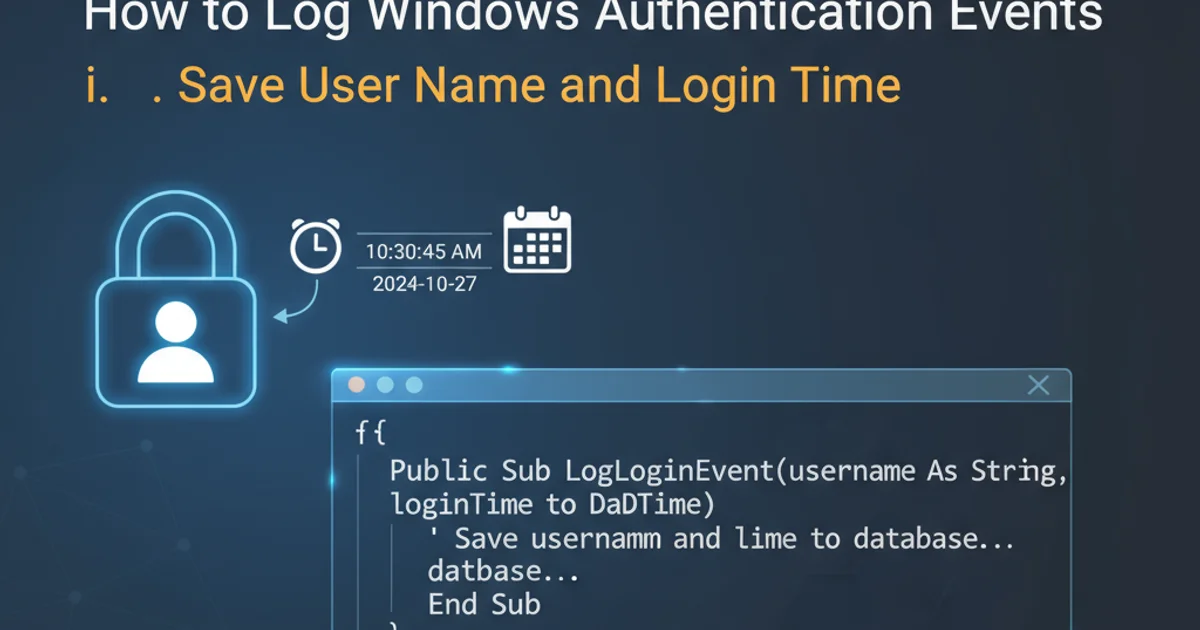asp.net vb2010 How to log Windows Authentication events - i.e. save user name and login time
Categories:
Logging Windows Authentication Events in ASP.NET (VB.NET)

Learn how to capture and log Windows authenticated usernames and login times in your ASP.NET applications using VB.NET, enhancing security auditing and user activity tracking.
Windows Authentication provides a robust way to integrate your ASP.NET application with your organization's existing user directory (like Active Directory). While it handles the authentication process seamlessly, you often need to log these events for auditing, security analysis, or tracking user activity. This article will guide you through capturing the authenticated username and the login timestamp in an ASP.NET application using VB.NET.
Understanding Windows Authentication Context
When Windows Authentication is enabled for an ASP.NET application, the web server (IIS) handles the initial authentication handshake with the client. Once a user is successfully authenticated, IIS passes the user's identity to the ASP.NET application. This identity is then accessible through the HttpContext.Current.User object, which represents the currently authenticated user principal. This object contains information about the user, including their identity.
sequenceDiagram
participant Browser
participant IIS
participant ASP.NET_App
Browser->>IIS: Request Page (e.g., Default.aspx)
IIS->>Browser: Request Windows Credentials
Browser->>IIS: Provide Credentials
IIS->>IIS: Authenticate User (via AD/Local)
IIS->>ASP.NET_App: Pass Authenticated User Identity
ASP.NET_App->>ASP.NET_App: Access HttpContext.Current.User
ASP.NET_App->>ASP.NET_App: Log User Identity & Timestamp
ASP.NET_App->>IIS: Process Request
IIS->>Browser: Return Page ContentSequence diagram of Windows Authentication and logging in ASP.NET
Retrieving User Information and Timestamp
The core of logging Windows Authentication events involves two main pieces of information: the authenticated username and the time of the event. The username can be retrieved from HttpContext.Current.User.Identity.Name. This property typically returns the username in the format DOMAIN\username or username@domain. The timestamp can simply be obtained using DateTime.Now.
Imports System.Web
Imports System.Security.Principal
Partial Class _Default
Inherits System.Web.UI.Page
Protected Sub Page_Load(ByVal sender As Object, ByVal e As System.EventArgs) Handles Me.Load
If User.Identity.IsAuthenticated Then
Dim authenticatedUserName As String = User.Identity.Name
Dim loginTime As DateTime = DateTime.Now
' For demonstration, display in a Label or Console
Response.Write("Authenticated User: " & authenticatedUserName & "<br />")
Response.Write("Login Time: " & loginTime.ToString() & "<br />")
' In a real application, you would log this to a database, file, or event log.
LogAuthenticationEvent(authenticatedUserName, loginTime)
Else
Response.Write("User is not authenticated via Windows Authentication.")
End If
End Sub
Private Sub LogAuthenticationEvent(ByVal userName As String, ByVal eventTime As DateTime)
' --- Implement your logging mechanism here ---
' Example: Log to a simple text file
Dim logFilePath As String = Server.MapPath("~/App_Data/AuthLog.txt")
Using writer As New System.IO.StreamWriter(logFilePath, True)
writer.WriteLine("[" & eventTime.ToString("yyyy-MM-dd HH:mm:ss") & "] User: " & userName & " logged in.")
End Using
' Example: Log to a database (pseudo-code)
' Dim connectionString As String = ConfigurationManager.ConnectionStrings("MyDbConnection").ConnectionString
' Using conn As New SqlConnection(connectionString)
' Dim cmd As New SqlCommand("INSERT INTO LoginEvents (UserName, LoginTime) VALUES (@UserName, @LoginTime)", conn)
' cmd.Parameters.AddWithValue("@UserName", userName)
' cmd.Parameters.AddWithValue("@LoginTime", eventTime)
' conn.Open()
' cmd.ExecuteNonQuery()
' End Using
' Example: Log to Windows Event Log
' Dim eventLog As New System.Diagnostics.EventLog("Application")
' eventLog.Source = "MyWebAppAuth"
' eventLog.WriteEntry("User " & userName & " logged in at " & eventTime.ToString(), System.Diagnostics.EventLogEntryType.Information)
End Sub
End Class
VB.NET code to retrieve and log Windows authenticated user and login time.
Configuring IIS and Web.config for Windows Authentication
Before your ASP.NET application can leverage Windows Authentication, you must configure both IIS and your application's web.config file. In IIS, ensure that Windows Authentication is enabled for your application and Anonymous Authentication is disabled. In web.config, you need to specify the authentication mode.
<?xml version="1.0" encoding="utf-8"?>
<configuration>
<system.web>
<authentication mode="Windows" />
<authorization>
<deny users="?" />
<!-- Deny anonymous users -->
<allow users="*" />
<!-- Allow all authenticated users -->
</authorization>
<compilation debug="true" targetFramework="4.0" />
</system.web>
<system.webServer>
<security>
<authentication>
<anonymousAuthentication enabled="false" />
<windowsAuthentication enabled="true" />
</authentication>
</security>
</system.webServer>
</configuration>
web.config configuration for Windows Authentication.
web.config will prevent unauthenticated users from accessing your application. Ensure this is the desired behavior for your application.1. Enable Windows Authentication in IIS
Open IIS Manager, navigate to your application, and in the 'Authentication' feature, disable 'Anonymous Authentication' and enable 'Windows Authentication'.
2. Configure web.config
Add the <authentication mode="Windows" /> and <authorization> sections to your system.web node, and the <windowsAuthentication enabled="true" /> and <anonymousAuthentication enabled="false" /> settings to your system.webServer node as shown in the example above.
3. Implement Logging Logic
In your ASP.NET page's Page_Load event (or a more centralized location like Global.asax), retrieve User.Identity.Name and DateTime.Now, then call your custom logging function to persist this data.
4. Test Your Application
Deploy your application and access it from a client machine within your Windows domain. Verify that the user's identity and login time are correctly logged by checking your chosen logging destination (e.g., text file, database, event log).